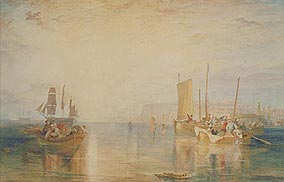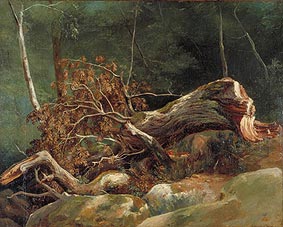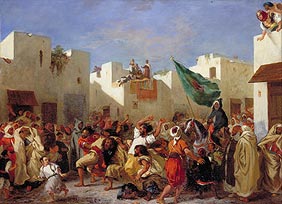|
The Rise of Watercolor
 The
British excelled in the art of watercolor. Often dubbed the "British
medium," watercolor was practiced in France during the first
two decades of the nineteenth century with some regularity, but
little genius. Two-thirds of the British entries at the 1824 Paris
Salon were watercolors. Technically sophisticated and imposing in
scale, they shocked French critics, who generally considered watercolor
painting a frivolous pastime. However, such opposition could not
suppress the groundswell of interest in watercolors among French
collectors. The
British excelled in the art of watercolor. Often dubbed the "British
medium," watercolor was practiced in France during the first
two decades of the nineteenth century with some regularity, but
little genius. Two-thirds of the British entries at the 1824 Paris
Salon were watercolors. Technically sophisticated and imposing in
scale, they shocked French critics, who generally considered watercolor
painting a frivolous pastime. However, such opposition could not
suppress the groundswell of interest in watercolors among French
collectors.
Watercolor appealed to French Romantic painters as a means to help
liberate technique. So rapidly did the fashion take hold in Paris
that by 1830 French critics were claiming that watercolor had rescued
the visual arts from the shallowness of monumental history painting
and was contributing daily to the artistic liberation of the people.
The more sympathetic commentators in France and Britain credited
the technical rejuvenation of watercolor to the prodigious originality
of the Anglo-French trained Richard Parkes Bonington, whose watercolors
Delacroix aptly described as "diamonds that flatter and ravish
the eye." Between 1826 and 1828, when Bonington and Delacroix
were virtually sharing studios, they and the artists of their entourage—Huet,
Colin, Roqueplan, Decamps, Barye, Boys, and Isabey—defined
a new relationship between watercolor and oil painting that would
ultimately lead to Impressionism.
The Poetry of Landscape Painting
 Few
observers on either side of the Channel disputed the originality
of the British landscape school. However, the aims of British and
French landscape painters diverged markedly. Few
observers on either side of the Channel disputed the originality
of the British landscape school. However, the aims of British and
French landscape painters diverged markedly.
French artists, like their British contemporaries, sketched in
the open air to encourage spontaneity and careful
observation of natural light and color. But these qualities often
vanished in the final painting when prescribed rules of
composition intruded —when planar recession replaced atmospheric,
minute details crammed every inch, and skies were painted according
to for-mulae. Finished landscapes were meant to accommodate an elevated
subject from mythology or literature, set in Italy because of its
associations with an idealized classical past.
By contrast, British painters offered finished works that retained
the freshness of the original sketch, with a poetic sentiment derived
from the immediate experience of nature. Paul Huet vividly recalled
his initial sight of Constable’s View on the Stour in
1824: "It was the first time that one felt the freshness, that
one saw a luxuriant, verdant nature, without blackness, crudity
or mannerisms." It was the "sincerity" of Bonington’s
vision that inspired Camille Corot to become
an artist.
Through the influence of these British artists, the coastal towns
of Normandy, the countryside around Paris, and northern Italy sites
steeped in medieval romance (such as Venice) gradually replaced
Rome as destinations for the serious pursuit of landscape painting.
Later in the century, they became favorite subjects of the Impressionists.
Art on View: Salons and Exhibitions
Outside the grand galleries of the Louvre itself, there is nothing
comparable to this exhibition’s final gallery in scale and
dazzling content. The concluding section of "Crossing the Channel"
evokes the visual drama and diversity of public art exhibitions
in the 1820s and 1830s, when artists and paintings traveled as never
before between London and Paris.
Virtually all the paintings in this section were shown at one of
the major exhibition venues. These included the Paris Salon, held
in the Louvre, and the annual exhibitions at the Royal Academy and
British Institution in London. These events served as public forums
for a creative dialogue between French and British artists.
 Masterworks
such as Delaroche’s Execution of Lady Jane Grey, Delacroix’s
Fanatics of Tangier and John Martin’s The Deluge
are hung together for the first time in nearly two centuries. Constable’s
two six-foot landscapes, View on the Stour and The White Horse,
have not previously been loaned for exhibition outside of their
respective museums. Masterworks
such as Delaroche’s Execution of Lady Jane Grey, Delacroix’s
Fanatics of Tangier and John Martin’s The Deluge
are hung together for the first time in nearly two centuries. Constable’s
two six-foot landscapes, View on the Stour and The White Horse,
have not previously been loaned for exhibition outside of their
respective museums.
British paintings constituted a fraction of the art shown in France
during this period. Nevertheless, these paintings had tremendous
influence, especially those featured at the so-called "British
Salons" of 1824 and 1827. They ignited heated comparisons of
the two cultures and served as a rallying point for a French school
of painting both divided and in transition. These icons of Romanticism
defined the critical debate on modernism for future generations
of artists in both countries.
|


![]()
![]()
![]()
 The
British excelled in the art of watercolor. Often dubbed the "British
medium," watercolor was practiced in France during the first
two decades of the nineteenth century with some regularity, but
little genius. Two-thirds of the British entries at the 1824 Paris
Salon were watercolors. Technically sophisticated and imposing in
scale, they shocked French critics, who generally considered watercolor
painting a frivolous pastime. However, such opposition could not
suppress the groundswell of interest in watercolors among French
collectors.
The
British excelled in the art of watercolor. Often dubbed the "British
medium," watercolor was practiced in France during the first
two decades of the nineteenth century with some regularity, but
little genius. Two-thirds of the British entries at the 1824 Paris
Salon were watercolors. Technically sophisticated and imposing in
scale, they shocked French critics, who generally considered watercolor
painting a frivolous pastime. However, such opposition could not
suppress the groundswell of interest in watercolors among French
collectors.  Few
observers on either side of the Channel disputed the originality
of the British landscape school. However, the aims of British and
French landscape painters diverged markedly.
Few
observers on either side of the Channel disputed the originality
of the British landscape school. However, the aims of British and
French landscape painters diverged markedly.  Masterworks
such as Delaroche’s Execution of Lady Jane Grey, Delacroix’s
Fanatics of Tangier and John Martin’s The Deluge
are hung together for the first time in nearly two centuries. Constable’s
two six-foot landscapes, View on the Stour and The White Horse,
have not previously been loaned for exhibition outside of their
respective museums.
Masterworks
such as Delaroche’s Execution of Lady Jane Grey, Delacroix’s
Fanatics of Tangier and John Martin’s The Deluge
are hung together for the first time in nearly two centuries. Constable’s
two six-foot landscapes, View on the Stour and The White Horse,
have not previously been loaned for exhibition outside of their
respective museums. 